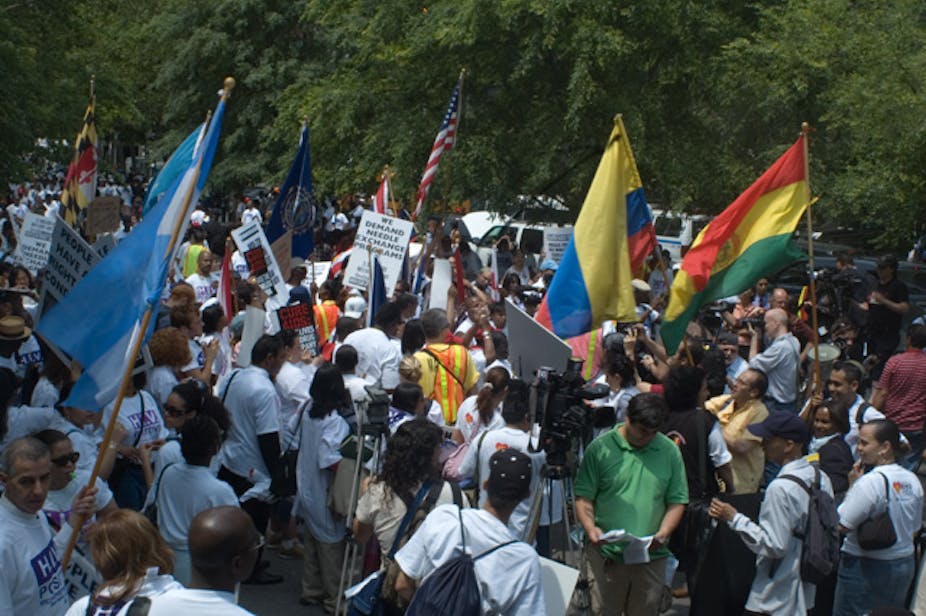The theme for World AIDS Day this year is “HIV is still here”. It was chosen because we don’t hear quite so much these days as we once did about HIV or AIDS.
In 2012, it will be 30 years since the first case was diagnosed in Australia. Over the course of these decades, the image of this virus, as it is constructed in public imagination, has charted a profound course.
Arguably, public perceptions of HIV/AIDS in Australia have reached a point where it’s generally viewed in a global context. We increasingly see it as a disease that belongs to the developing world, rather than something that is “still here” in Australia.
But HIV/AIDS does still have a presence in Australia and its 30-year milestone marks a useful point to reflect on how Australian attitudes toward the virus have been, and continue to be, shaped on a local level.

When HIV/AIDS first emerged in the early 1980s its image was a product of attitudes toward homosexuality. People suspected HIV/AIDS to be a disease exclusive to gay men, referring to it as Gay Related Immune Deficiency (GRID) or the more derogatory “gay plague”.
Early scientific theories regarding its cause pointed to factors such as excessive amounts of semen in the blood stream from anal intercourse or gay men’s over-use of amyl nitrate (“party poppers”).
Although it wasn’t far into the 1980s when the first cases of AIDS were diagnosed in heterosexual Australians, the belief in an inherent association between AIDS and the lifestyle and sexual choices of gay men seemed firmly fixed in public consciousness.
HIV/AIDS was depicted as a disease of immorality and deviance. Conservative media painted a picture of gay men as irresponsible and dangerous, guilty not only of their misdirected sexual predilections but of their potential to infect and kill “normal” Australians.
For a time, it seemed that HIV/AIDS would provide license for a formal crackdown on gay civil liberties and a backward slide away from the public acceptance that had built throughout the 1970s.
The media debated the merits of compulsory HIV testing for gay men, banning lesbian and gay events and quarantining people with AIDS.
Perhaps what is most remarkable then about the history of HIV/AIDS in Australia is the extent to which AIDS activists successfully created a platform not only to disentangle the public image of HIV/AIDS from homophobia but to challenge homophobic attitudes more generally.
AIDS activists, most of whom were gay men, mobilised a response to HIV that involved strategically fostering relationships with sympathetic journalists and providing them with regular and consistent information about scientific and medical aspects of HIV/AIDS.

Over time, Australian media came to expect, and seek, content from activists. Thus a large amount of the information about HIV/AIDS being fed through media to the public came to be marked with the particular language and ideology of AIDS activists.
AIDS activists challenged the media, for instance, to stop promoting the notion that some people were “innocent” victims of AIDS, while gay men weren’t.
The highly organised gay community response to HIV/AIDS prevention also meant that AIDS activists came to be seen by government policy makers as legitimate players in the public health response to HIV/AIDS. As a result, they were often afforded “expert status” within the media.
Paradoxically, the devastation HIV/AIDS brought to the gay community also brought unprecedented opportunities for gay activists to construct public knowledge about homosexuality.
Before this, media and political debate on homosexuality in Australia had been dominated by criminologists, psychiatrists or the church. Gay men and lesbians were spoken “about” but rarely spoken “to”.
In response to HIV/AIDS, gay activists built a legitimate public profile for the gay community, allowing gay men and lesbians, as well as people living with HIV/AIDS, a human face and encouraging a more sympathetic attitude toward HIV/AIDS.
So did this have an impact on the public image of HIV/AIDS? Or is it just that 30 years down the track attitudes to homosexuality have changed and the focus on the virus has shifted to other counties?

In 2007, the Australian media picked up on the idea of “gift giving”, following the criminal trial of a Victorian man alleged to have deliberately infected others with HIV (so called “gift giving”).
The case translated well into sensationalist media headlines implying a sordid gay undercurrent of “gift giving” had been uncovered in Melbourne.
Media reporting on the case hinted at a once-familiar discourse of irresponsible gay men, not to be trusted where HIV/AIDS was concerned. But reports didn’t contain the same level of vitriol that we saw in the 1980s.
Gay community advocates had a strong presence in media reporting and efforts were made by some journalists to link the story to a broader discussion about the adequacy of current funding for HIV prevention.
HIV/AIDS may always be seen, to some extent, as a gay disease in Australia. But the history of AIDS activism is a unique example of the way in which community advocates can successfully play a role in reconstructing the public image of an illness.
Dr Jennifer Power’s book “Movement, Knowledge, Emotion: Gay activism and HIV/AIDS in Australia” is now available through ANU E-press.

